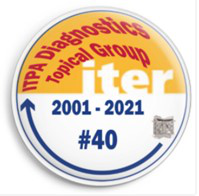Speakers
Description
The WEST tokamak is currently being prepared for long pulse operation with a water-cooled full metallic first wall to test ITER-like plasma facing components. Tungsten will be the main impurity source in the vessel and its concentration in the core plasma will limit the device performances as it is expected to be the case in ITER. Heating will be provided by radio-frequency systems, including lower hybrid current drive (LHCD). In this context PPPL has built two complementary cameras for energy and space-resolved measurements of the soft and hard x-rays. These measurements will be used to study the impurity (W) transport, to infer the electron temperature, the fast electron tail density produced by LHCD and runaway electrons, and the beam-target emission of tungsten at the edge due to fast electron losses interacting with the target.
The two cameras share the same compact design and both have horizontal lines-of-sight: while the SXR camera has a symmetric field of view that covers most of the plasma cross-section, the HXR camera is slightly titled to intersect the lower divertor. Both systems are based on a novel 2D pixel array x-ray detector with adjustable threshold energy at the pixel level. This innovation provides a great flexibility in the energy configuration allowing simultaneous space and energy resolved x-ray measurements. The SXR camera uses a silicon detector calibrated in the range 2.3 - 21 keV. The HXR camera uses a cadmium telluride detector calibrated in the range 8 - 100 keV.
A synthetic diagnostic was developed for both cameras to assess their capabilities. SXR emission for a given impurity mix in the plasma was modelled using the collisional-radiative code FLYCHK. HXR emission produced by thermal electrons and fast electrons generated by LHCD was modelled using the suite of codes C3PO/LUKE/R5-X2.
Both diagnostics are installed and will provide measurements starting from the next WEST campaign (March 2022).

